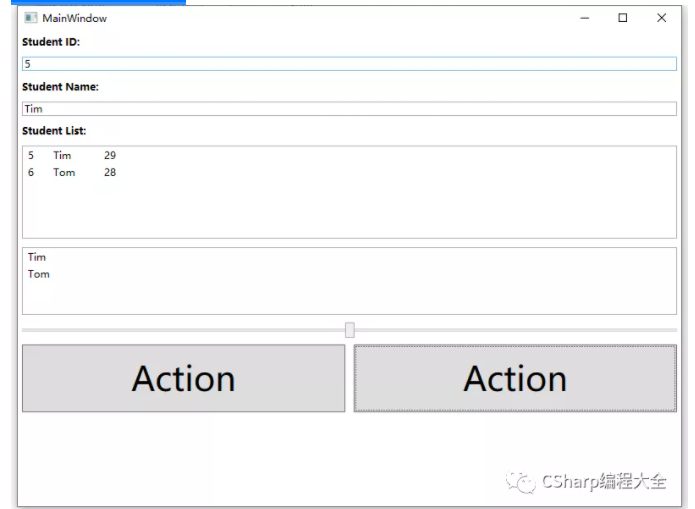WPF 数据绑定实例一
前言:
数据绑定的基本步骤:
(1)先声明一个类及其属性
(2)初始化类赋值
(3)在C#代码中把控件DataContext=对象;
(4)在界面设计里,控件给要绑定的属性{Binding 绑定类的属性}
原理:监听事件机制,界面改变有TextChanged之类的事件,所以改变界面可以同步修改到对象
想让普通对象实现数据绑定,需要实现INotifyPropertyChanged接口才能监听ProperChanged。具体代码如下显示:
class Person:INotifyPropertyChanged
{
private int age;
public int Age
{
get
{
return age;
}
set
{
this.age = value;
if (PropertyChanged != null)
{
PropertyChanged(this,
new PropertyChangedEventArgs("Age"));
}
}
}
}
BindingMode枚举值
| 名称 | 说明 |
|---|---|
| OneWay | 当源属性变化时更新目标属性 |
| TwoWay | 当源属性变化时更新目标属性,当目标属性变化时更新源属性 |
| OneTime | 最初根据源属性设置目标属性,其后的改变会忽略。 |
| OneWayToSource | 与OneWay类型相似,但方向相反。 |
| Default | 此类绑定依赖于目标属性 |
UpdateSourceTrigger
| 名称 | 说明 |
|---|---|
| Default | 默认值,与依赖属性有关 |
| Explicit | 必须在显示地调用BindingExpression.UpdateSource的情况下才更新源。 |
| LostFocus | 控件失去焦点的时候更新源值 |
| PropertyChanged | 绑定的目标值改变时更新。 |
实例运行后界面如下:

MainWindow.xaml
<Window x:Class="WpfApp1.MainWindow"
xmlns="http://schemas.microsoft.com/winfx/2006/xaml/presentation"
xmlns:x="http://schemas.microsoft.com/winfx/2006/xaml"
xmlns:d="http://schemas.microsoft.com/expression/blend/2008"
xmlns:mc="http://schemas.openxmlformats.org/markup-compatibility/2006"
xmlns:local="clr-namespace:WpfApp1"
mc:Ignorable="d"
Title="MainWindow" Height="600" Width="800">
<StackPanel>
<TextBlock Text="Student ID:" FontWeight="Bold" Margin="5"/>
<TextBox Name="textBoxId" Margin="5" Text="{Binding Id,Mode=TwoWay}"/>
<TextBlock Text="Student Name:" FontWeight="Bold" Margin="5"/>
<TextBox Name="textBoxName" Margin="5" Text="{Binding Name,Mode=TwoWay}"/>
<TextBlock Text="Student List:" FontWeight="Bold" Margin="5"/>
<ListBox Name="listBox1" Height="110" Margin="5" >
<ListBox.ItemTemplate>
<DataTemplate>
<StackPanel Orientation="Horizontal">
<TextBlock Text="{Binding Path=Id}" Width="30"/>
<TextBlock Text="{Binding Path=Name}" Width="60"/>
<TextBlock Text="{Binding Path=Age}" Width="30"/>
</StackPanel>
</DataTemplate>
</ListBox.ItemTemplate>
</ListBox>
<ListBox Name="listBox2" Height="80" ItemsSource="{Binding Student}" DisplayMemberPath="Id" Margin="5"/>
<Slider Name="slider1" MinHeight="25" Value="{Binding Id}"/>
<Grid>
<Grid.RowDefinitions>
<RowDefinition Height="*"></RowDefinition>
</Grid.RowDefinitions>
<Grid.ColumnDefinitions>
<ColumnDefinition Width="*"/>
<ColumnDefinition Width="*"/>
</Grid.ColumnDefinitions>
<Button Grid.Column="0" Content="Action" FontSize="40" Name="btnCtrl1" Height="80" Margin="5" Click="BtnCtrl1_Click"/>
<Button Grid.Column="1" Content="Action" FontSize="40" Name="btnCtrl2" Height="80" Margin="5" Click="BtnCtrl2_Click"/>
</Grid>
</StackPanel>
</Window>
首先解释下C#中的Task.Delay()和Thread.Sleep()
-
Thread.Sleep()是同步延迟,Task.Delay()是异步延迟。
-
Thread.Sleep()会阻塞线程,Task.Delay()不会。
-
Thread.Sleep()不能取消,Task.Delay()可以。
-
Task.Delay()实质创建一个运行给定时间的任务,Thread.Sleep()使当前线程休眠给定时间。
-
反编译Task.Delay(),基本上讲它就是个包裹在任务中的定时器。
-
Task.Delay()和Thread.Sleep()最大的区别是Task.Delay()旨在异步运行,在同步代码中使用Task.Delay()是没有意义的;在异步代码中使用Thread.Sleep()是一个非常糟糕的主意。通常使用await关键字调用Task.Delay()。
-
我的理解:Task.Delay(),async/await和CancellationTokenSource组合起来使用可以实现可控制的异步延迟。
MainWindow.xaml.cs
using System;
using System.Collections.ObjectModel;
using System.ComponentModel;
using System.Threading.Tasks;
using System.Windows;
namespace WpfApp1
{
/// <summary>
/// MainWindow.xaml 的交互逻辑
/// </summary>
public partial class MainWindow : Window
{
public ObservableCollection<Student> stuList;
public MainWindow()
{
InitializeComponent();
this.DataContext = new Student() { Name="111", Id =1 };
Task.Run(async() => //开启异步线程task
{
await Task.Delay(3000); //延时3秒
Dispatcher.Invoke((Action)delegate //线程中主界面显示需要用委托,不然这次赋值,在界面不更新
{
this.DataContext = new Student() { Name = "222", Id = 2 };
});
});
this.DataContext = new Student() { Name = "333" , Id = 3 };
}
private void BtnCtrl1_Click(object sender, RoutedEventArgs e)
{
Student stu = new Student() { Id = 4, Name = "Jon", Age = 29 }; //实例化一个Student类 并给类成员赋值
this.DataContext = stu;//将实例化得对象传给DataContext
}
private void BtnCtrl2_Click(object sender, RoutedEventArgs e)
{
ObservableCollection<Student> stuList = new ObservableCollection<Student>() //具有通知属性的list
{
new Student() { Id=5, Name="Tim", Age=29 },
new Student() { Id=6, Name="Tom", Age=28 },
};
this.listBox1.ItemsSource = stuList;
this.listBox2.ItemsSource = stuList;
this.listBox2.DisplayMemberPath = "Name";
this.DataContext = stuList;
}
}
public class Student : INotifyPropertyChanged //创建一个继承自INotifyPropertyChanged的类Student
{
private string name;
public string Name
{
get { return name; }
set
{
name = value;
if (this.PropertyChanged != null)
{
PropertyChanged(this, new PropertyChangedEventArgs("Name")); //给Name绑定属性变更通知事件
}
}
}
private int id;
public int Id
{
get { return id; }
set
{
id = value;
if (this.PropertyChanged != null)
{
this.PropertyChanged.Invoke(this, new PropertyChangedEventArgs("Id"));//给Id绑定属性变更通知事件
}
}
}
private int age;
public int Age
{
get { return age; }
set
{
age = value;
if (this.PropertyChanged != null)
{
this.PropertyChanged.Invoke(this, new PropertyChangedEventArgs("Age"));//给Age绑定属性变更通知事件
}
}
}
public int ID { get; internal set; }
public event PropertyChangedEventHandler PropertyChanged;
}
}
想了解更多C#知识,请扫描下方二维码

需加微信交流群的,请加小编微信号z438679770,切记备注 加群,小编将会第一时间邀请你进群!


